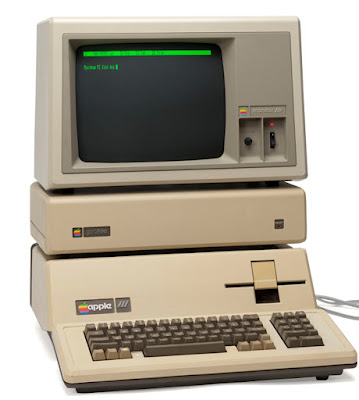Introduced November 1980
The legendary Apple II series was one of the most successful computers ever, selling millions of units in a 16 year run from 1977 to 1993. But despite that success, Apple repeatedly tried to kill off the Apple II and replace it with something better. The Apple III was the first attempt… and one of the most disastrous.
 |
| Apple III with Profile Hard Disk |
It was released to the market in November 1980, and on paper it looked like it should succeed – based on the 6502 processor like its predecessor, it had 128Kb of RAM included, supported lowercase characters (unlike the Apple II), built-in colour graphics and 80 column text and a new operating system called Apple SOS. A floppy disk was included as standard, and the Apple III also had sound.
Despite the similarity in hardware, the Apple III wasn’t compatible with the Apple II in normal operations, but it did have a special emulation mode it could be booted into. But this was one of the Apple III’s many poor design decisions – the Apple III could only emulate an Apple II with 48Kb of memory when a lot of software demanded the full 64Kb. There wasn’t any good technical reason for this either, it was purely a marketing decision. Similar access to other advanced parts of the Apple III hardware (such as the 80 column display and lowercase letters) were deliberately blocked too, but the memory limitations meant that the Apple III did not make a very good Apple II.
Unfortunately the problems ran much deeper. The physical design of the Apple III had been determined by the marketing team, not the engineering team. So when it came to squeezing all the bits in, the engineers couldn’t make it all fit. To get round this, the Apple III motherboard was designed with very narrow tracks and a large number of soldered-on components to save space. However, the quality of the manufacturing process was not up to such precise work and a large proportion of Apple IIIs were faulty out of the box.
Overheating was a major problem too – in order to keep noise and size to a minimum, the III had no fans but instead was meant to dissipate heat into the aluminium casing. Heating would lead to system crashes and according to legend, chips would pop out of their sockets and disks could melt. Other hardware problems included a faulty real-time clock which would eventually fail and be difficult to replace.
A chronic lack of software was combined with a lack of documentation, making it had for independent developers to create new software and hardware. Compared to this, the Apple II had a huge software library and the system was well-documents and easy to work with.
The launch was a complete disaster, and it soon became clear that Apple hadn’t done any real testing on this unit and the product was unfit for purpose. Sales were quickly suspended and all the sold units recalled for re-engineering. A redesigned circuit board (and the removal of the troublesome clock) fixed most of the issues and the Apple III was re-introduced to market a year later, in November 1981.
 |
| Apple III Plus |
Consumers were not keen on the revised model at all, because the reputation of the early ones was so bad that it tainted the newer and more reliable models. A lightly revised Apple III Plus launched in December 1983 did not turn around sales either and in April 1984 the entire product line was permanently cancelled.
In three and a half years of on-off sales, the Apple III had only shipped about 120,000 units – and many of these were to replace faulty ones. The entire project lost tens of millions of dollars, but fortunately for Apple it survived because of buoyant sales of the Apple II. Apple’s next main product launch following the Apple III was the Apple Lisa, which was also a high-profile commercial failure.
It took more than a decade to kill of the Apple II – the Mac LC from 1990 helped – by which time the Apple III had been long forgotten. Today, Apple III systems are rare but usually only cost a few hundred dollars for one in working order.
Image credits:
Adam Jenkins via Flickr - CC BY 2.0
Tellegee via Wikimedia Commons - CC BY-SA 4.0

No comments:
Post a Comment